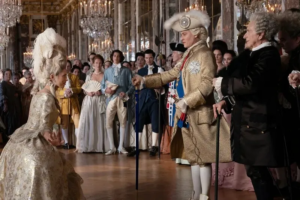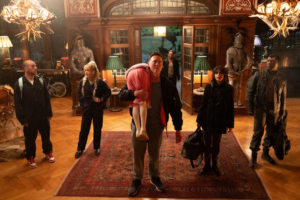Caravaggio’s Shadow Reviewed by GREG KING
Director: Michele Placido
Stars: Riccardo Scamarcio, Louis Garrel, Isabelle Huppert, Tedua, Brenno Placido, Michele Placido, Maurizio Donadoni, Micaela Romazzotti, Lolita Chammah, Gianfranco Gallo, Vinicio Marchioni, Alessandro Haber, Moni Ovadia.

Caravaggio’s Shadow, a lavish Italian/French co-production from actor turned director Michele Placido looks at the final years in the life of Caravaggio (born Michelangelo Merisi). This is something of a passion project for Placido, who had been fascinated with the artist for over half a century and had long wanted to explore his life and legacy on screen.
Caravaggio was a sixteenth century painter and regarded as one of the most prominent Italian artists of his generation with his realistic depiction of the human form. His work was a huge influence on Baroque painting. But Caravaggio used prostitutes, beggars and thieves as his models, transforming whores into the Virgin Mary and thieves into saints on his canvas. This earned him the ire of the Catholic Church. He died under mysterious circumstances in Tuscany in 1610, but this film, written by Sandro Petraglia (The Best Of Youth, etc), Fidel Signorile (The Front Line, etc) and Placido himself offers up a plausible solution to that mystery. Derek Jarman’s 1986 biopic Caravaggio similarly explored the artist’s debauched lifestyle, but he gave the material more of a homoerotic subtext.
Caravaggio (played here by Riccardo Scamarcio, recently seen in the star studded mystery A Haunting In Venice, etc) had earlier been involved in a street brawl with Ranuccio Tomassoni (played by the director’s son Brenno Placido), the gangster son of a wealthy family, and was forced to flee Rome. He gained temporary sanctuary in Naples, while he hoped for a Papal pardon. But Pope Paul V (Maurizio Donadoni) decided to investigate the painter and the rumours concerning his debauched lifestyle to see if he was deserving of such treatment. He sent a papal inquisitor (Louis Garrel, from The Innocent, etc), known simply as Ombra (the shadow) to question some of his patrons and those who knew him best. This included the Marquessa Colonna (Isabelle Huppert) who had first offered him shelter when he fled to Naples and patron and art collector the Cardinal del Monte (played by the director himself).
Caravaggio’s Shadow explores much the same details as Jarman’s film, but here Placido and his co-writers employ a non-linear narrative structure that jumps back and forth in time, which makes for a muddled film that may confuse those in the audience who are unfamiliar with the famous artist and his life and work. Nonetheless this is a visually superb production as cinematographer Michele D’Attanasio (A Brighter Tomorrow, etc) imbues the film with the chiaroscuro look and feel of a Caravaggio painting through his dramatic use of light and shadows. Much of the drama plays out using natural light or candlelight.
The two leads create a distinct contrast physically with their appearance. Scamarcio makes for a great fit with the ruggedly handsome and charismatic Caravaggio with his wonderful performance capturing his lusty personality, his bawdy lifestyle and his moral ambivalence. Garrel’s character is fictitious, but he brings out the darker nature and sinister side of this shadowy Vatican investigator.
The filmmakers have also been granted access to many of the artist’s paintings housed in art galleries and museums around the world which adds authenticity to the material. Great production values, from Tonino Zera’s set design and Carlo Poggioli’s costumes, further enhances the authenticity of the film, capturing the gritty streets of seventeenth century Naples, their sights, sounds and smells pulsating with life, and drawing a stark contrast with the opulence of the Vatican and the Catholic church.
And the film intrigues us, making us want to learn more about the controversial painter and his work.
★★★



